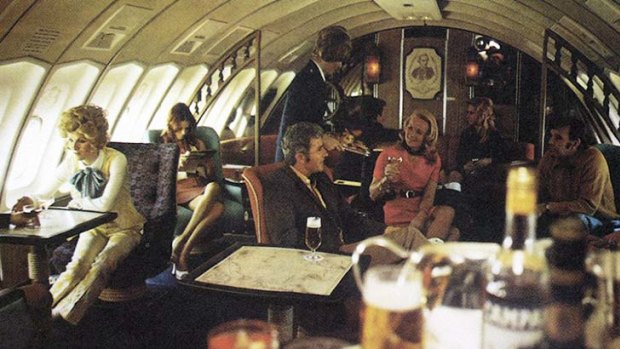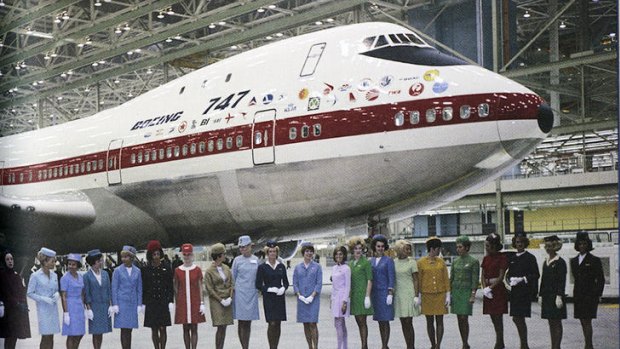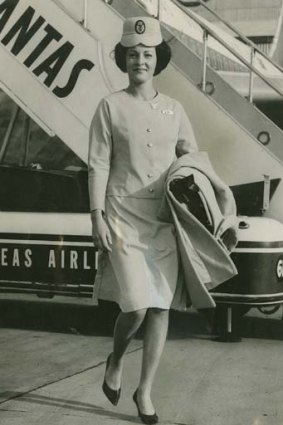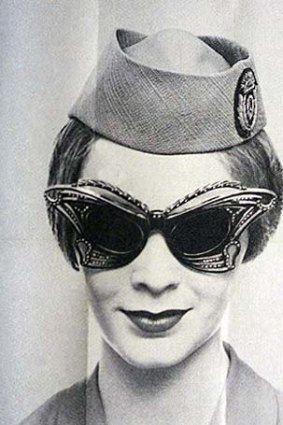This was published 12 years ago
A toast to the hosts with the most
The changing role and fashion of the flight attendant tells a greater tale, writes Tim Barlass.
IF YOU are reading this in economy class, squeezed between two passengers and with a half-eaten pasta bake languishing under a foil lid in front of you, then you might be excused for thinking that the glamour has long gone out of flying.
Certainly that is the view of Prudence Black, an honorary associate in gender and cultural studies at the University of Sydney. As the author of a new book into the changing role and fashion of the flight attendant, Dr Black ponders what happened to the days when passengers travelled in three-piece suits or mink coats and high heels, and used bone china cups and starched napkins.
And what of the flight attendant who would position the cushion behind your head, but who now barely has time to pause as she hurries through the cheap seats?

High flying ... Dr Prudence Black's book, The Flight Attendant's Shoe, details how this once highly desirable profession evolved, as women and fashion did, over the decades.
"Why is it that the job of the flight attendant, once loaded with cosmopolitan mystique, has ended up parodied for its drab routines?" she asks in The Flight Attendant's Shoe.
Dr Black has some of the answers.
"The flight attendant as epitome of glamour, for whom 'the sky was the limit', has become severely localised and restricted," she said.
There is no denying there has been a shift in the way a highly desirable profession has, in many respects, been reduced to just another customer service role.
In more recent times, September 11 transformed their role into something of an in-flight safety expert.
"But there is no denying there has been a shift in the way a highly desirable profession has, in many respects, been reduced to just another customer service role," she adds.
But it was not always this way. The air hostess, or air stewardesses as they were known in the early days of aviation - before the name was changed to the less romantic and more workman-like "cabin crew" - held jobs that were the envy of many. It was an era when women would dress up and wear gloves just to go to the airport.

From " the Flight Attendant's shoe". This photo from 1968 shows flight hostesses representing the 26 airlines who placed orders for the Boeing 747Qantas flight hostess Pat tutor wearing Aqua is in the middle.
Qualification for a job with Qantas in 1948 included evidence of first aid experience, a height to about 5 feet 7 inches, weight to 9 stone 7 pounds and knowledge of a foreign language. Should an air hostess decide to get married, she would be required to resign and "hand in her uniform".
Unlike now, when you might sneak a peek at a quick application of lippy before landing, hostesses were expected to change into a fresh uniform at any of the destinations along the Kangaroo Route to Britain.
Dr Black writes: "This would require considerable effort as they would have to change in the tiny bathroom on board. Many of the hostesses remember trying to struggle into the uniform in this extremely confined space and reaching the point of almost passing out through the effort."

Qantas Cabin crew, 1964.
Some of the duties would be considered demeaning today.
One flight attendant's handbook in the 1930s suggested: "Passengers who wish to remove their shoes should be assisted and the shoes cleaned by the hostess before returning them." You don't get that treatment on a domestic flight today.
There was also an opportunity for flight attendants to prove their credentials as both "attractive" and "charming" in the Miss Air Hostess Quest which began in Australia in 1962. To win the competition was seen as a sign of "feminine achievement".

Darling, come fly with me.
The emphasis on beauty is echoed in the comment of one Qantas hostess recruited in 1967.
"I was in training school a bit longer as my skin wasn't very good … they wouldn't let me fly until my skin was better … I was sent to a skin specialist and got put on the pill," she said.
The clock was ticking, though - by 1968 court rulings in the US allowed flight stewardesses to marry and remain working after they turned 30. In the 1970s weight restrictions were liberalised and by 1978 they could also keep their jobs if they became pregnant.
Transformation of the flight attendants' fashion has gone through as much turbulence as the role itself.
Barbara Harding-Smith, a former Qantas hostess, recounts arriving at the St Moritz Hotel in New York in 1959 wearing the regulation navy wool greatcoat, handy for crossing windswept tarmacs in the northern hemisphere, together with a crew of 10 men. It was cocktail hour and one of the glamorous New York set, speculating who they were, was overheard to say: "They gotta be part of the Russian navy."
The military postwar look gave way to smarter uniforms, jungle green, aqua, bright orange, kangaroos and designers including Emilio Pucci, Yves Saint Laurent and the Peter Morrissey with his indigenous boomerang shiny brown dot print. Not everyone liked the boomerang print - in 2005 Qantas set up a London crew base and one flight attendant had to commute on the underground.
"Can you imagine sitting in a brown boomerang dress on the Piccadilly line? The best you can do is cover up completely," she said.
Some Qantas staff said they could judge the size of their fellow stewardesses by counting the number of boomerangs across their bottoms.
In the 1970s trousers became an option, but had to be taken off on board (and presumably replaced) as they could not be worn while serving passengers.
Other airlines experimented with white knee-length patent leather boots and paper dresses which could be cut to the regulation three inches above the knee. Some passengers tried to burn through the dresses with cigarette ends (you could smoke then), but they were made from fireproof material.
Dr Black says that contrary to the view that the hostess uniform was an "antithesis of fashion", the stories in her book, published next month by NewSouth, are "overwhelmingly tales of pride and pleasure in wearing the uniform that took Australians to places they had dreamt about, and even further."
Prepare for takeoff
Set aside one night each week to delve into your personal appearance. We call this our "Desert Island Night".
1. Relaxing bath.
2. Finger and toenails.
3. Hair - scrubbed clean, combed and brushed.
4. Skin care.
5. Superfluous hair removal.
6. Odd jobs - mending etc.
7. At least 8 hours restful sleep with plenty of fresh air.
The next morning you will not only feel healthier and cleaner, but look a different person. There is a virtuous feeling knowing you and your possessions are spic and span and you will make certain your workday matches the mood of the orderliness.
Source: Qantas flight hostess training manual 1963
Sign up for the Traveller Deals newsletter
Get exclusive travel deals delivered straight to your inbox. Sign up now.